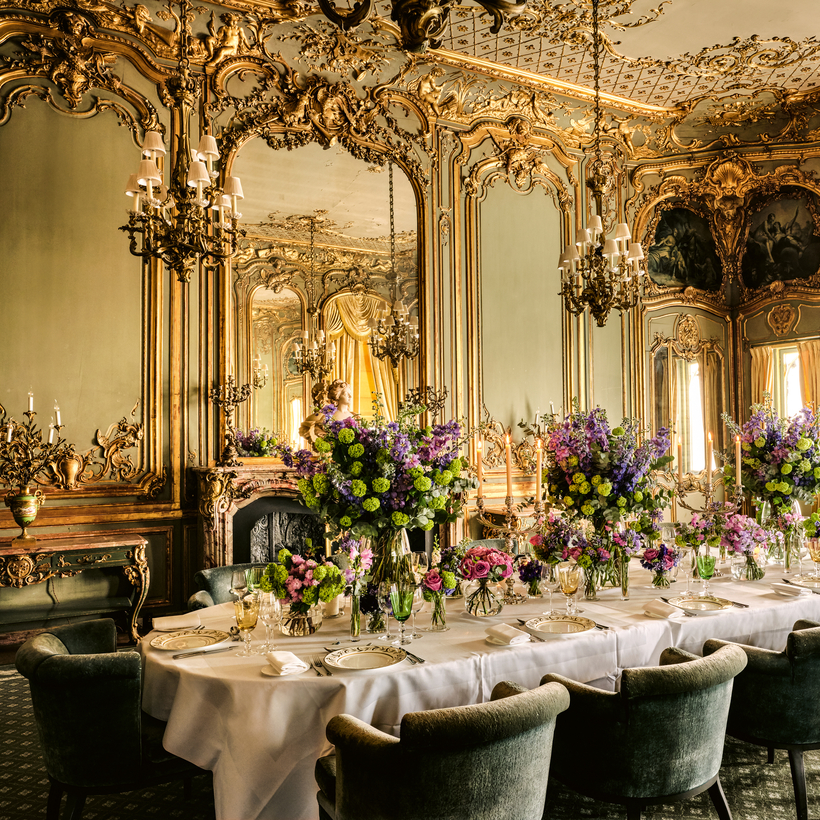If taste could be inherited, Jane Churchill, one of London’s most prominent interior designers for more than four decades, was born with a fortune. Nancy Astor was her great-great-aunt, and the grandmother of Emily Astor, co-author of the new book Entertaining in Style: Nancy Astor and Nancy Lancaster—Table Settings, Recipes, Flower Arrangements, and Decorating. Nancy Lancaster was also Jane’s great-aunt. Both women were renowned hostesses of their time and are still revered as icons of style to this day.
Entertaining in Style pays homage to them, their accomplishments, and their way of life. It also explains what made these particular women so important, so influential, and, let’s not forget, so amusing. It’s a story told through their recipes, their approach to entertaining, and Jane’s memories of growing up in their legendary English country houses.

“The Two Nancys,” as they were sometimes referred to, were actually American, born in Virginia and raised near Charlottesville, at Mirador, the country seat of the family patriarch, Chiswell Dabney Langhorne, a railroad-and-tobacco tycoon. Langhorne and his wife, Nanaire Keene, had five daughters, celebrated as the “Langhorne Sisters” for their beauty and Southern-belle charm. The eldest, Lizzie, married Thomas Moncure Perkins, a Richmond cotton broker. Nancy Lancaster was their daughter, as was Jane Churchill’s grandmother Alice Perkins Winn.
“My grandmother and her sister Nancy Lancaster, were very close,” Jane notes. “They fought like cats and dogs but adored one another. Both lived till they were 97. Strong American women—that’s where my blood comes from.” If anyone fits that description, it’s Nancy Astor.

In 1906, she married Waldorf Astor, the second Viscount Astor and the unbelievably rich heir to much of his famous American grandfather John Jacob Astor III’s real-estate-lumber-and-fur empire, which placed her at age 27 in the center of Britain’s highest aristocratic and political circles. As a wedding present, Waldorf’s father, William Waldorf Astor, who had transplanted the family from New York to England, gave them Cliveden, a vast estate dating back to the 1600s, set above the Thames an hour outside London.
In 1919, Nancy became the first woman elected to Parliament, where she would remain until 1945, and continued hosting the lavish weekend house parties for what came to be known as the “Cliveden Set,” mixing top Conservative Party politicians with the likes of Charlie Chaplin, Rudyard Kipling, George Bernard Shaw, Edith Wharton, and T. E. Lawrence (a.k.a. “Lawrence of Arabia”). “One of my earliest memories is of Christmas at Cliveden when I was four,” recalls Jane. “Nancy Astor died when I was 16, and she had kept every single thank-you note from my brother Henry, my sister Melissa, and me for presents she had given us over the years. She was a big influence.”

For her part, Nancy Lancaster was said to have “the finest taste of almost anyone in the world.” Indeed, she would come to be seen as the most influential interior decorator of her generation and, as a partner in Colefax and Fowler, was credited with upgrading and promoting the traditional-English-country-house look.
In 1920, she married Ronald Tree, a scion of Chicago’s Marshall Field department-store dynasty but who had been born and raised in England. In 1933, they bought Ditchley Park, in Oxfordshire, an enormous stately pile built in 1722 for the second Earl of Lichfield and designed by James Gibbs. Working with Lady Sibyl Colefax and Stéphane Boudin of the Paris firm Jansen, she set about transforming Ditchley into the most stylish house in England.

In the late 1940s, the Trees divorced, and Nancy wed Lieutenant Colonel Claude Lancaster. In 1954, a year after that marriage dissolved, Nancy bought Haseley Court, an early-18th-century manor house near Oxford, which she renovated and decorated with John Fowler. Jane was seven years old at the time, and from then on “we spent every school holiday at Haseley. Those days were the highlight of our year.” As for the fabulous Lancaster entertaining style: “It wasn’t so much lavish as well put together. And delicious. It wasn’t over-rich, just very good—both my grandmother’s and Nancy’s, neither of whom could boil water.”
Jane’s mother had continued the Langhorne tradition of marrying into the English aristocracy, in her case to the Honorable Mark Wyndham, younger brother of Lord Egremont of Petworth, Sussex. And, in 1970, Jane herself wed Lord Charles Spencer-Churchill, a cousin of Winston Churchill’s, and a grandson of the American heiress Consuelo Vanderbilt, later Consuelo Spencer-Churchill, Duchess of Marlborough.

Meanwhile, Jane’s career at her great-aunt Nancy Lancaster’s firm, Colefax and Fowler, led her to launch Jane Churchill Design in 1982, where, over the years, her client list has come to include everyone from the crown prince of Malaysia to cosmetics queen Estée Lauder.
I asked Jane Churchill if the famous line “Living well is the best revenge”—attributed to the 16th-century Church of England clergyman and metaphysical poet George Herbert, and used by Calvin Tomkins as the title of his 1971 biography of the Roaring 20s icons Gerald and Sara Murphy—could be applied to her ancestors, the legendary Two Nancys.
“They didn’t need revenge,” she replied. “They had what they wanted. They just lived well. They loved to entertain the family. That was their raison d’être.”

Bob Colacello is an Editor at Large for AIR MAIL and the author of the foreword to Entertaining in Style, excerpted here


 Discover
Discover